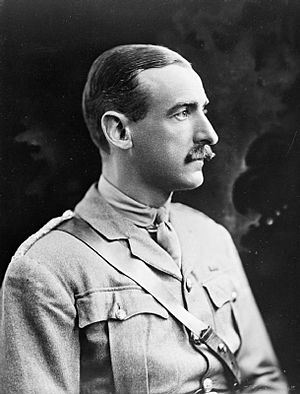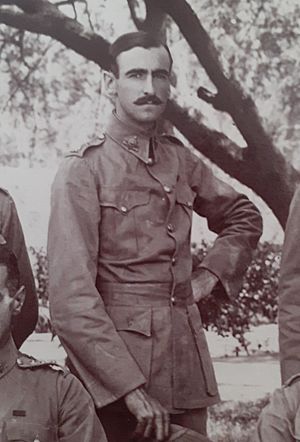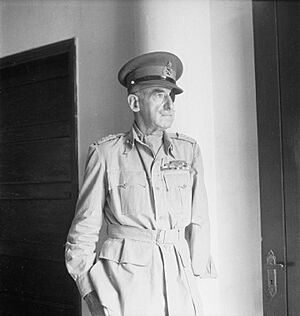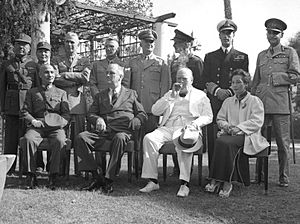Adrian Carton de Wiart facts for kids
Quick facts for kids
Sir Adrian Carton de Wiart
|
|
|---|---|

Lieutenant Colonel Carton de Wiart during the First World War
|
|
| Birth name | Adrian Paul Ghislain Carton de Wiart |
| Born | 5 May 1880 Brussels, Belgium |
| Died | 5 June 1963 (aged 83) Aghinagh House, Killinardrish, County Cork, Ireland |
| Buried |
Killinardish Churchyard, County Cork, Ireland
|
| Allegiance | United Kingdom |
| Service/ |
British Army |
| Years of service | 1899–1923 1939–1947 |
| Rank | Lieutenant-general |
| Service number | 836 |
| Commands held | 61st Infantry Division 134th Brigade 12th Brigade 8th (Service) Battalion, Gloucestershire Regiment |
| Battles/wars | Second Boer War First World War
Polish-Soviet War |
| Awards | Victoria Cross Knight Commander of the Order of the British Empire Companion of the Order of the Bath Companion of the Order of St Michael and St George Distinguished Service Order Mentioned in Despatches Virtuti Militari (Poland) Croix de guerre (Belgium) Legion of Honour (France) Croix de Guerre (France) |
Lieutenant-General Sir Adrian Paul Ghislain Carton de Wiart (born May 5, 1880 – died June 5, 1963) was a brave British Army officer. He was born in Belgium to Belgian and Irish parents. He received the Victoria Cross, which is the highest award for bravery in battle in many Commonwealth countries.
Sir Adrian fought in the Boer War, First World War, and Second World War. He was wounded many times, losing an eye and fingers. He even survived two plane crashes and escaped from a prisoner-of-war camp. Despite all this, he once wrote, "Frankly, I had enjoyed the war."
After the Second World War, he became Winston Churchill's personal representative in China. He also attended the Cairo Conference. People often thought he was the inspiration for a character in a famous book series called Sword of Honour. He was known for his eyepatch and missing arm, looking like an "elegant pirate."
Contents
Early Life and First Battles
Growing Up
Adrian Carton de Wiart was born in Brussels, Belgium, on May 5, 1880. His father was a lawyer and worked in Egypt. Adrian spent his early years in Belgium and England. When he was six, his family moved to Cairo, Egypt, where he learned to speak Arabic.
He later went to a boarding school in England called The Oratory School. After that, he studied at Balliol College, Oxford. But he left college early to join the British Army.
Fighting in South Africa
Around 1899, Adrian joined the army during the Second Boer War in South Africa. He used a false name and pretended to be older than he was. He was wounded in the stomach and leg during this war.
After recovering, he went back to Oxford briefly. Then he joined the Second Imperial Light Horse and fought in South Africa again. In 1901, he officially became an officer in the 4th Dragoon Guards. He was sent to India in 1902, where he enjoyed sports like shooting and pig sticking.
Life as an Officer
Adrian's injuries from the Boer War made him very focused on staying fit. He ran, jogged, and played sports often. He was known for his strong language but was a fun person to be around.
In 1904, he became an aide-de-camp (a personal assistant) to a senior general in South Africa. This job gave him time to play polo, which he loved. Even though he had served in the British Army for eight years, he was still a Belgian citizen. In 1907, he officially became a British citizen.
In 1908, he married Countess Friederike Fugger von Babenhausen from Austria. They had two daughters. Adrian was well-connected in Europe and often traveled to hunt in different countries. In 1910, he was promoted to captain.
First World War Heroics
Fighting in Somaliland
When the First World War began, Adrian was on his way to British Somaliland (now part of Somalia). He was helping fight against a leader known as the "Mad Mullah." During an attack on an enemy fort, he was shot twice in the face. He lost an eye and part of his ear. For his bravery, he received the Distinguished Service Order (DSO) in 1915.
On the Western Front
In February 1915, he went to France to fight on the Western Front. He led different groups of soldiers and was wounded seven more times during the war. He lost his left hand in 1915. He even pulled off his own fingers when a doctor couldn't remove them! He was shot in the skull, ankle, hip, leg, and ear in different battles.
Receiving the Victoria Cross
In 1916, Adrian Carton de Wiart received the Victoria Cross (VC). This is the highest award for bravery in battle for British Empire forces. His Victoria Cross is now on display at the National Army Museum in London.
He was promoted several times during the war, becoming a temporary brigadier general. One soldier described him arriving for an inspection, missing an eye and two limbs, with many wound stripes. Despite his injuries, he was still very sharp, even noticing a soldier's untied shoelace.
After the First World War
Mission to Poland
After the war, Carton de Wiart was sent to Poland. He was part of the British-Poland Military Mission. Poland was fighting several wars at the time, including against Bolshevik Russia in the Polish-Soviet War.
He met important Polish leaders like Marshal Józef Piłsudski. He also advised Cardinal Achille Ratti, who later became Pope Pius XI, about whether diplomats should leave Warsaw during the fighting. Adrian felt great sympathy for the Polish people and supported them. He even fought off Red cavalry with his revolver from a train!
He retired from the army in 1923 with the honorary rank of major general.
Life in Poland (1924–1939)
Adrian became good friends with a Polish prince named Karol Mikołaj Radziwiłł. The prince let him use a large estate called Prostyń in eastern Poland, a huge wetland area. Adrian spent 15 peaceful years there, mostly hunting. He said, "In my fifteen years in the marshes I did not waste one day without hunting."
His quiet life ended in July 1939 when he was called back to duty. He became the head of the British Military Mission to Poland again. Soon after, Nazi Germany attacked Poland on September 1, 1939, starting the Second World War. The Soviet Union also attacked Poland from the east. Adrian lost all his belongings at Prostyń, but he said, "they did not manage to take my memories."
Second World War Adventures
Polish Campaign (1939)
Adrian met with the Polish commander, Marshal Edward Rydz-Śmigły, before the German invasion. He advised the Poles to move their forces back, but his advice wasn't fully taken. He did convince them to move their navy ships out of the Baltic Sea, which helped the Allies later.
As Poland fell, Adrian and his mission had to escape. His car convoy was attacked by German planes (Luftwaffe), and a friend's wife was killed. He escaped from Romania by plane with a false passport.
Norwegian Campaign (1940)
In April 1940, Adrian was sent to lead a British-French force in Norway. Their goal was to capture the city of Trondheim. His plane was attacked by German fighters when he landed. The town of Namsos, where his troops landed, was bombed and destroyed.
His troops faced many challenges: no artillery, no transport, no air cover, and deep snow. They were attacked by German ski troops and planes. Adrian recommended pulling out, and eventually, the troops were evacuated by sea. He returned to Britain on his 60th birthday, May 5, 1940.
Prisoner of War in Italy (1941–1943)
In 1941, Adrian was sent to lead a British mission to Yugoslavia. His plane crashed into the sea off the coast of Libya, and he had to swim to shore. He was captured by Italian forces.
He was held in a special prison for senior officers. He made friends with other generals there. Adrian tried to escape five times, including digging a tunnel for seven months! Once, he escaped for eight days disguised as an Italian farmer, even though he couldn't speak Italian and was 62 years old with an eyepatch and one arm.
In 1943, the Italian government secretly wanted to leave the war. They asked Adrian to help them send a message to the British about a peace treaty. He was released and traveled to Lisbon, then returned to England in August 1943.
Mission to China (1943–1947)
Soon after returning, Adrian was sent to China as Winston Churchill's personal representative. His job was to improve relations between Britain and China during the war. He attended the Cairo Conference with Churchill, U.S. President Roosevelt, and Chinese leader Chiang Kai-shek.
Adrian was based in Chongqing, the wartime capital of China. He admired the Chinese people, writing that they were hardworking and cheerful. He regularly flew to India to meet British officials. He also met Mao Zedong, the leader of the Chinese Communists, and even challenged him during a dinner.
After Japan surrendered in 1945, Adrian flew to Singapore for the official surrender. He retired in October 1947, at the age of 66, with the honorary rank of lieutenant-general.
Later Life and Passing
On his way home, Adrian had an accident in Rangoon, falling down stairs and breaking several bones. His first wife passed away in 1949. In 1951, at 71, he married Ruth Myrtle Muriel Joan McKechnie, who was 23 years younger. They settled in Ireland.
Sir Adrian Carton de Wiart died on June 5, 1963, at the age of 83. He and his wife Joan are buried in a churchyard near their home in Ireland.
Awards and Decorations
Carton de Wiart received many awards for his bravery and service:
| Victoria Cross (VC) | 1916 | |
| Knight Commander of the Order of the British Empire (KBE) | 1945 | |
| Companion of the Order of the Bath (CB) | 1919 | |
| Companion of the Order of St Michael and St George (CMG) | 1918 | |
| Companion of the Distinguished Service Order (DSO) | 1915 | |
| Queen's South Africa Medal | For service in South Africa | |
| Africa General Service Medal | For service in Somaliland | |
| 1914 Star | ||
| British War Medal | ||
| Victory Medal (United Kingdom) | ||
| 1939–45 Star | ||
| Africa Star | ||
| Burma Star | ||
| Italy Star | ||
| War Medal 1939-1945 | ||
| King George VI Coronation Medal | 1937 | |
| Queen Elizabeth II Coronation Medal | 1953 | |
| Officer of the Order of the Crown (Belgium) | 1917 | |
| Croix de guerre 1914–1918 (Belgium) | 1918 | |
| Silver Cross of the Order of Military Virtue of Poland | 1920 | |
| Cross of Valour (Poland) | Two awards (1920, 1941) | |
| Commander of the Legion of Honour of France | ||
| Croix de guerre 1939–1945 (France) |
Images for kids
-
Painting by Sir William Orpen, 1919
See Also
- Jack Churchill, another notably eccentric British officer








